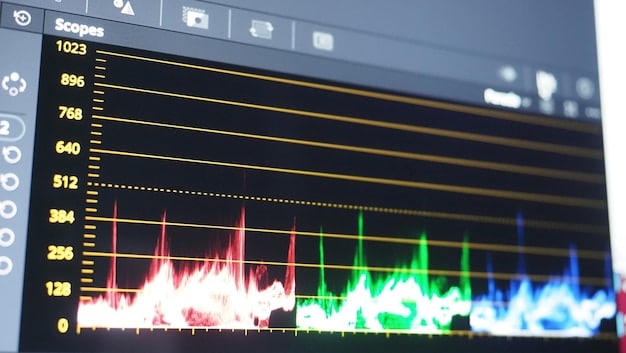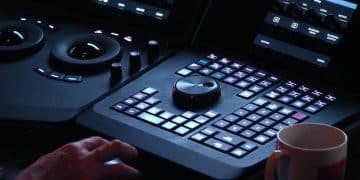Sidechain Compression: The Underground Rap Producer’s Secret Weapon

Sidechain compression is a mixing technique essential for underground rap producers, creating rhythmic pumping effects by ducking one sound’s volume based on another, typically the kick drum, adding energy and clarity to the mix.
Unlock the power of sidechain compression in your underground rap productions. This guide provides you with everything you need to know to create powerful, dynamic mixes that stand out.
What is Sidechain Compression? A Deep Dive
Sidechain compression is more than just a mixing trick; it’s a creative tool that adds rhythm and groove to your tracks. Understanding its core principles will allow you to enhance your underground rap beats.
At its most basic, sidechain compression uses the signal from one audio source to control the volume of another. This is typically achieved by using the kick drum to trigger a compressor on a bassline or synth, creating a “pumping” effect.
The Core Principles Explained
To truly master sidechain compression, you need to grasp the key elements that make it work. Understanding these concepts will give you the control you need to shape your sound effectively.
- Threshold: Determines the level at which the compressor starts to engage.
- Ratio: Controls the amount of gain reduction applied to the signal once the threshold is exceeded.
- Attack: Sets how quickly the compressor starts reducing the gain after the trigger signal is detected.
- Release: Determines how quickly the compressor returns the signal to its original level after the trigger signal stops.
By carefully adjusting these parameters, you can sculpt the rhythmic feel of your track. Experiment with different settings to find the perfect balance for your underground rap production.
In summary, sidechain compression is a dynamic process involving threshold, ratio, attack, and release to modulate one signal’s volume based on another, enhancing rhythm and clarity.
The Essentials: Setting Up Sidechain Compression
Setting up sidechain compression might seem daunting at first, but it’s a straightforward process once you understand the steps involved. Let’s break it down to make it simple and easy to implement in your workflow.
The basic setup involves routing the signal you want to be compressed (e.g., the bassline) through a compressor plugin, and then setting the kick drum or another rhythmic element as the sidechain input. This input then triggers the compressor, creating the desired effect.

Step-by-Step Guide to Sidechain Routing
Follow these steps to set up sidechain compression in your DAW. The exact steps may vary depending on your DAW, but the general principles remain the same.
- Insert a compressor plugin: Place a compressor plugin on the track you want to sidechain (e.g., the bassline or synth).
- Enable sidechain input: In the compressor plugin, activate the sidechain input. This is usually labeled “Sidechain,” “External Sidechain,” or something similar.
- Route the trigger signal: Send the signal you want to use as the trigger (e.g., the kick drum) to the sidechain input of the compressor. In most DAWs, this involves using a send or aux track.
- Adjust compressor settings: Tweak the threshold, ratio, attack, and release settings to achieve the desired pumping effect.
Once you have your routing set up, you can fine-tune the compressor settings to create the perfect rhythmic groove. Don’t be afraid to experiment—that’s how you discover new and interesting sounds.
In essence, setting up sidechain compression involves inserting a compressor, activating its sidechain input, routing the trigger signal, and adjusting the compressor settings to achieve the targeted effect.
Crafting Your Sound: Compressor Parameters for Underground Rap
The beauty of sidechain compression lies in its versatility. By carefully adjusting the compressor parameters, you can tailor the effect to suit the unique character of your underground rap beats.
Different compressor settings will produce vastly different results. A fast attack and release will create a tight, punchy feel, while slower settings will result in a smoother, more subtle effect.
Decoding Attack and Release Times
Attack and release times are crucial for shaping the feel of your sidechain compression. Experiment with these settings to create the perfect groove for your underground rap production.
- Fast Attack: Allows the compressor to clamp down quickly on the signal, creating a very noticeable pumping effect. Great for aggressive, hard-hitting beats.
- Slow Attack: Delays the onset of compression, allowing some of the initial transient through. Can create a smoother, more subtle effect.
- Fast Release: Causes the compressor to release quickly, resulting in a tight, rhythmic pulse.
- Slow Release: Allows the compressor to release gradually, creating a smoother, more sustained effect.
Consider the tempo of your track and the rhythmic characteristics of your kick drum when setting these parameters. Adjust them until you achieve the desired groove and feel.
To summarize, attack and release times are critical parameters in sidechain compression; fast times create punchy effects, while slower times offer a smoother, more subtle feel, tailored for underground rap rhythms.
Beyond the Basics: Advanced Sidechain Techniques
Once you’ve mastered the basics of sidechain compression, you can start exploring more advanced techniques to create even more interesting and unique effects. The possibilities are truly endless.
Experiment with different trigger sources, explore creative routing options, and use EQ to further shape the sound of your sidechained elements.
Creative Routing and Trigger Sources
Think outside the box when it comes to routing and trigger sources. The more creative you get, the more unique your sound will become.
- Using a Ghost Kick: Create a separate kick drum track that’s only used for sidechaining. This allows you to create complex rhythmic patterns without affecting the actual beat.
- Sidechaining to Snares or Percussion: Try sidechaining to other rhythmic elements besides the kick drum. Snares, hi-hats, or percussion can create interesting and unexpected grooves.
- Multi-Band Sidechaining: Use a multi-band compressor to sidechain different frequency ranges independently. This allows for more precise control over the sidechain effect.
Don’t be afraid to experiment and push the boundaries of what’s possible. The best way to learn is by trying new things and discovering what works for you.
To conclude, advanced sidechain compression involves creative routing such as using ghost kicks, sidechaining to various percussion elements, and multi-band techniques for unique and precise rhythmic effects.

Common Pitfalls and How to Avoid Them
Sidechain compression is a powerful tool, but it’s also easy to misuse. Knowing the common pitfalls will help you avoid mistakes and create professional-sounding mixes.
Over-compression, unnatural pumping, and loss of dynamics are some of the common issues you might encounter. Mastering these common pitfalls and their solutions can mean the difference between a novice track and a professional-sounding piece.
Essential Troubleshooting Tips
Here are some troubleshooting tips to help you avoid common sidechain compression mistakes.
- Over-Compression: Avoid excessive gain reduction. This can make your track sound flat and lifeless. Use your ears and aim for a subtle, natural-sounding effect.
- Unnatural Pumping: If the sidechain effect sounds unnatural, adjust the attack and release times. Experiment until you find settings that create a smooth, musical groove.
- Loss of Dynamics: Be careful not to squash the dynamics of your track. Use sidechain compression sparingly and only where it’s needed to create the desired effect.
Remember, subtle adjustments can make a big difference. Pay attention to detail, and always trust your ears.
In summary, common pitfalls in sidechain compression include over-compression, unnatural pumping, and loss of dynamics, but these issues can be mitigated by careful adjustments and a discerning ear.
Practical Applications: Sidechaining in Underground Rap Subgenres
Sidechain compression can be applied to various subgenres of underground rap to enhance the overall sound and create unique effects. From trap to boom-bap, the possibilities are endless.
Understanding how to tailor sidechain compression to specific subgenres can help you create more authentic and impactful productions.
Tailoring Sidechain Compression to Different Styles
Here’s how you can apply sidechain compression to different subgenres of underground rap:
- Trap: Use a fast attack and release to create a tight, aggressive pumping effect on the bassline. This helps the bass cut through the mix and adds energy to the track.
- Boom-Bap: Opt for a slower attack and release to create a smoother, more subtle groove. This can add a gentle rhythmic pulse without being too overpowering.
- Lo-Fi Hip-Hop: Experiment with unconventional trigger sources, such as vinyl crackle or tape hiss, to create a unique and textured sidechain effect.
Each subgenre has its own unique sonic characteristics, so adjust your sidechain compression settings accordingly. Let your creativity guide you.
In brief, sidechain compression can be expertly tailored to different underground rap subgenres offering each a unique sound from punchy trap beats to subtle boom-bap grooves.
| Key Point | Brief Description |
|---|---|
| 🎧 Basic Principle | Uses one signal to control the volume of another. |
| ⚙️ Essential Parameters | Threshold, ratio, attack, and release are key adjustments. |
| 💡 Creative Routing | Experiment with ghost kicks and varied trigger sources. |
| ⚠️ Common Pitfalls | Avoid over-compression and unnatural pumping effects. |
Frequently Asked Questions (FAQs)
▼
Sidechain compression is mainly used to create rhythmic “pumping” effects by reducing the volume of one track when another, like a kick drum, plays. This makes the kick drum more prominent and adds groove.
▼
The key parameters are threshold, ratio, attack, and release. Threshold sets when compression starts, ratio controls the amount, attack dictates how fast it engages, and release determines how quickly it returns to normal.
▼
Yes, it can be used on various elements, such as synths, vocals, or even entire mixes. Experimenting with different sound sources can create unique and interesting rhythmic effects beyond the typical kick/bass setup.
▼
To avoid an unnatural sound, use moderate settings, particularly with attack and release times. Adjust them to match the tempo and rhythm of your track for a smoother, more musical feel that complements the song.
▼
A ghost kick is an inaudible kick drum track used solely to trigger sidechain compression, allowing for more complex rhythmic patterns without affecting the beat’s main percussive elements. This gives added flexibility.
Conclusion
By mastering the techniques outlined in this guide, you’ll be well-equipped to use sidechain compression effectively in your underground rap productions, adding depth, rhythm, and impact to your tracks.





